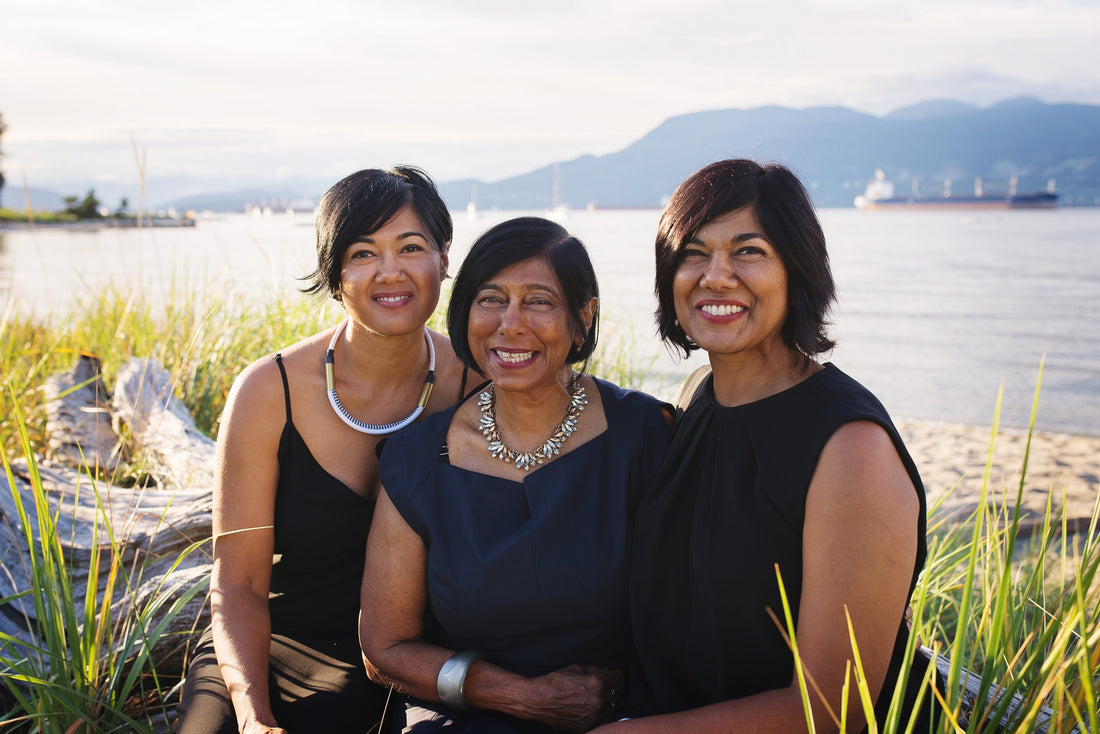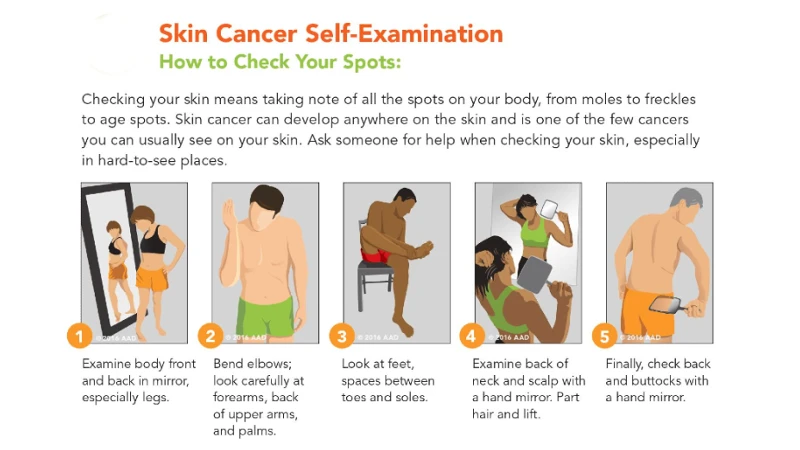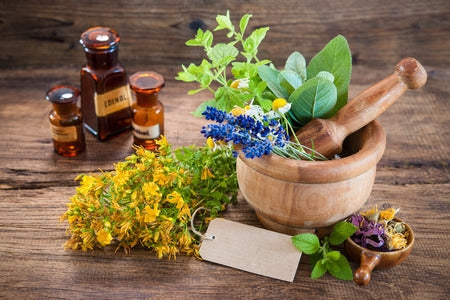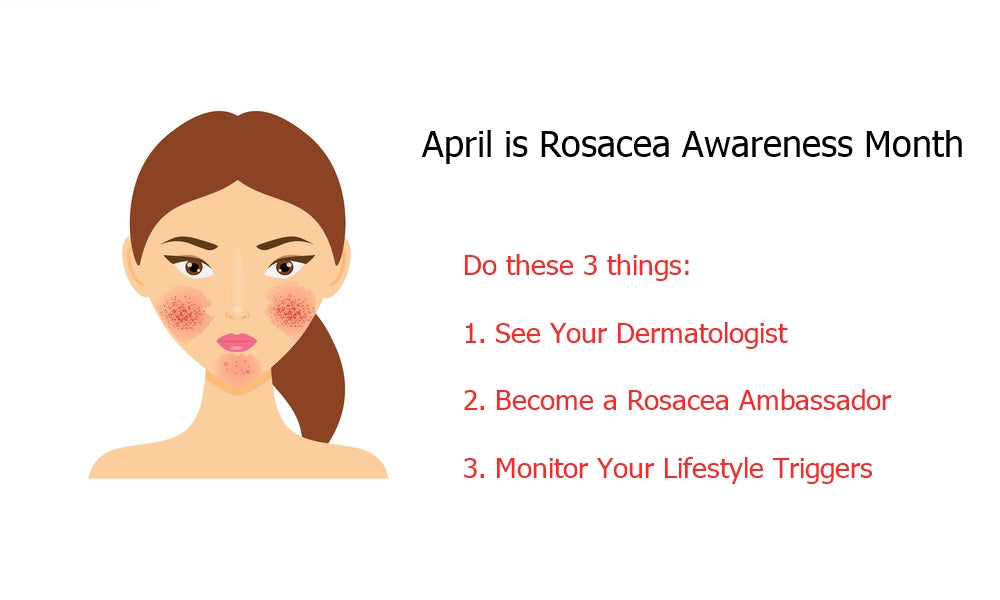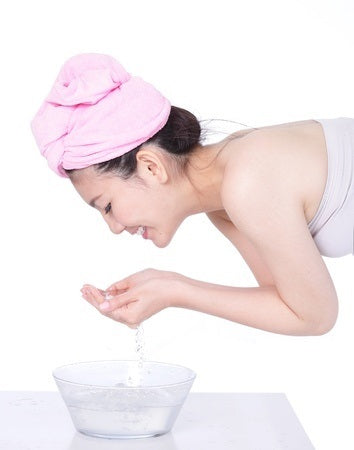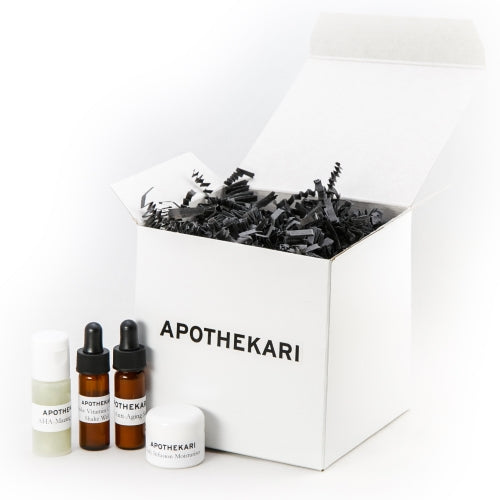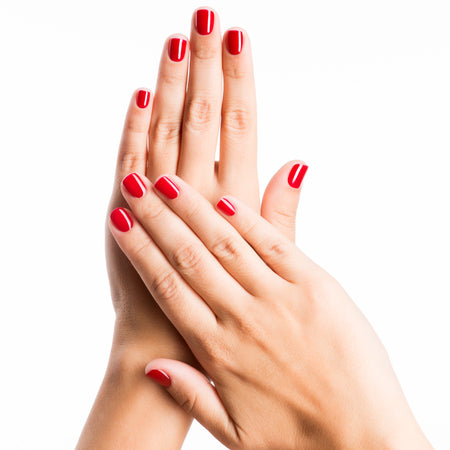Blog
Pharmacists & Skincare: It Makes Sense! (Part 2)
In Part 1 of Pharmacists & Skincare, I discussed the education and practical experience that pharmacists receive, which prepare them to advise patients about treatments for a wide range of health conditions. Whether it’s choosing the best cough and cold remedy, determining the correct supplement dosage or the most effective pain medication, a recommendation is based on evidence based analysis of the choices available and the individual needs of the patient in question. Shop All Apothekari Pharmacist Formulated Analytical training combined with care for patient safety and outcomes guides most pharmacists in their professional lives. I take this commitment seriously and apply it to all the products in the Apothekari line-up. Our treatments are filled with ingredients that are supported by clinical studies and at appropriate concentrations to deliver results. I take the same care in recommending skin care products as I would regarding anything else for your health. Pharmacists Consider These 5 Things When it Comes to Skincare Here are 5 guidelines that I take into consideration when formulating Apothekari treatments: Does It Work? In addition to my education and training as a pharmacist, I scour the internet, read journals and rely on professional and personal experience to gauge the efficacy of treatments at Apothekari. If a product’s ingredients don’t make sense from a clinical perspective then you won’t find it in our products. You’ll notice that we don’t offer bust enhancement creams, potions that claim to flatten your tummy or chase away your cellulite. Instead, our line contains gentle cleansers, potent serums and soothing moisturizers – products made with ingredients that are important and effective for great skin. Is It A Sound Formulation? I love to create so I like to experiment with various ingredients. I’ve had some pleasant outcomes, but it rarely happens the first time around. Formulating is part science and part art. Getting the right texture, colour and smell is important to ensure that our products appeal to a wide range of individuals. And it can take many, many trials and months of mixing, testing, experimenting and reformulating to ensure that the treatment remains stable and effective for its intended use. I work with qualified chemists who understand the science behind an ingredient’s pH, solubility and stability. They make sure that a product is just as pleasing when you open it up as it is when you are down to the bit at the bottom of the jar six months down the road. Is It Safe? I avoid ingredients that come with unpleasant side effects. This isn’t to say that you will never experience a side effect with any Apothekari product, as all skincare products have the potential for side effects in susceptible individuals. With any new topical treatment, it is wise to do a patch test first to ensure that you will not react to any given product. This is especially important if you have sensitive skin. Is It Well Preserved? For the sake of your health, please, please don’t buy into the preservative free fad. Preservatives are important and necessary to keep skincare products free from bacteria, yeast and mold. These and other nasty things are not what you want growing in your eye cream. The exception are oil based products, which often can be formulated preservative free. Would I Use It Myself? If a formulation isn’t something that I’d consider using or recommend to my family and friends then you won’t find it in our brand. It’s important that I offer products that deliver results so that you’ll feel confident in coming back to us. Marketing jargon and an overwhelming array of choices make it complicated to navigate the world of skincare. At times, it may seem downright impossible to choose the right products for your skin type and needs. At Apothekari, it’s my job to provide safe and effective products that will benefit your skin. I take this duty seriously and I am honored to be trusted with your needs. My team and I can’t wait to help you find the products that are just right for your skin! If you have any questions, we are always happy to help. Call us at 1.866.876.3649 or email us at info@apothekari.com and we will be happy to assist you.
Learn moreHappy Mother's Day
Mother’s Day. Often associated with Brunches, Bling and Bouquets, there’s no denying that it’s a hallmark holiday (gasp). Regardless, there is something special about setting aside a whole day to honor and celebrate the women who raised us. Shop All Apothekari Mother’s Day is a holiday that honours motherhood and that is observed throughout the world. Festivals celebrating mothers and motherhood can be traced back to the ancient Greeks and Romans, who held them in honor of the mother goddesses Rhea and Cybele. It’s more recent origins go back to 1870, when Julia Ward Howe – an abolitionist best remembered as the poet who wrote “Battle Hymn of the Republic” – worked to establish a Mother’s Peace Day. Howe dedicated the celebration to the eradication of war, and organized festivities in Boston for years. In 1908, Anna Jarvis conceived of Mother’s Day as a way of honoring the sacrifices mothers made for their children following her mother’s 1905 death. It became recognized as an official U.S. holiday in 1914. Jarvis later denounced the holiday’s commercialization and spent the latter part of her life trying to remove it from the calendar. While dates and celebrations vary around the globe, Mother’s Day most commonly falls on the second Sunday in May and traditionally involves presenting mothers with flowers, cards and other gifts. How We Celebrate Mother’s Day Sometimes, I get to start the day with a special breakfast. Never in bed; because, you know…Crumbs. I’m not a fan of tchotchkes. To me, one of the biggest indulgences is time. My family knows that I don’t expect presents so my gift is being able to steal away for an indulgent afternoon. Over the past few years, I’ve been fortunate enough to indulge with my sister (also a mom) and my mother for a glorious break that involves window shopping, walking and tea. In our food obsessed family, a celebration wouldn’t be one without food! Our lazy afternoon is often capped off by dinner prepared by the men and children in our family. To Moms everywhere – Happy Mother’s Day this year! I hope that you are indulged and loved by all those you care for.
Learn morePharmacists & Skincare: It Makes Sense! (Part 1)
When it comes to skincare, you may wonder if a pharmacist is adequately prepared to formulate treatments, give advice regarding suitable products and know when more serious care is required. A bit of healthy skepticism is a good thing so this is a valid question to ask! Shop All Apothekari Pharmacist Training Skincare While pharmacists aren’t dermatologists, they are highly trained healthcare professionals who undergo extensive training in a multi-year program (depending on the region, between four and six years) focusing on therapeutic knowledge and clinical skills. My education and training included a range of courses covering areas such as: Physiology (how plant and animal bodies work) Pathophysiology (diseases) Pharmacology (how drugs work) Pharmaceutical care (part of the health care team and patient care) Compounding (creating pharmaceutical products to fit the unique needs of patients). Pharmacists understand how drugs work, in particular, how they work in the human body. No other health care professional undergoes as much training with respect to drugs or medicines as pharmacists. This training also encompasses how to convey information in a way that individuals without a medical background can understand. Pharmacists may be generalists, but their analytical training prepares them to specialize in a range of areas where they feel they can deliver added value. These days, you’ll find pharmacists specializing in a wide range of fields including Psychiatry, Geriatrics, Pediatrics, Oncology and of course, Skincare! Pharmacists & Skincare: It Makes Sense! My pharmacist training and practical experience have prepared me well to work in the field of skincare, just as it would for any other medical specialty. Analytical and patient focused skills help me to sift through clinical studies, scrutinize ingredients and recognize whether a treatment or its active ingredients can make a difference to your health, including that of your skin. I take the potential for side effects seriously and question overstated benefits – the same thing I’d do for any aspect of your health. You won’t find hyped ingredients in Apothekari. Our science-based line is formulated with appropriate concentrations of active ingredients and botanicals that will improve the look and feel of your skin. I’ve done the research so you don’t have to! In Part 2, I’ll share with you the 5 guidelines I use to screen ingredients and formulate products at Apothekari. Let me know if you have any questions.
Learn moreMay is Skin Cancer Awareness Month
May is Skin Cancer Awareness Month and throughout the month of May, people are encouraged to do their part to raise awareness about skin cancer. Skin cancer is the most common form of cancer in the United States and the third most common in Canada. Fortunately, it is also one of the most preventable forms of cancer and highly treatable when detected early. Shop All Apothekari Most cases of melanoma, the deadliest kind of skin cancer, are caused by exposure to ultraviolet (UV) rays. Basal and squamous cell skin cancers are more common than melanoma, but Melanoma is the most likely form of skin cancer to grow and spread to other parts of the body, making it more difficult to treat. Risk Factors for Skin Cancer Include: Too much exposure to ultraviolet (UV) radiation from the sun or tanning beds Pale skin and natural red, or blond hair Family history of skin cancer Multiple or unusual moles Older age (though young people are not immune to skin cancer) Severe sunburns in the past How To Minimize Your Chances of Developing Skin Cancer Avoiding too much sun, covering up, and using sunscreen is the key to preventing skin cancer. Our sister store – Phamix.com – stocks a wide range of safe and effective sunscreens. If found and treated early, all forms of skin cancer are almost always curable. You can help reduce your chances of developing skin cancer by: Staying out of the sun during peak hours of the day when the sun’s rays are the strongest (10am to 4pm). Covering up as much of your body with protective clothing as possible when in the sun Apply generous amounts of sunscreen with broad spectrum protection and at least SPF of 30 or higher when outside. Reapply every two hours, or after swimming or sweating. Cover your head with a wide-brimmed hat, shading your face, ears, and neck. Wear sunglasses that block 100% of UVA and UVB rays to protect the eyes and surrounding skin. Avoid other sources of UV light, including tanning beds and sun lamps. Have regular skin cancer screenings to detect possible skin cancer in early stages. The American Academy of Dermatology’s 2017 SPOT Skin Cancer™ campaign — “Check Your Partner. Check Yourself” — is encouraging women to check both their partners and themselves for signs of skin cancer. When detected early, skin cancer — including melanoma, the deadliest form of skin cancer — is highly treatable. Research has shown that women are nine times more likely than men to notice melanoma on others, which means women could help save their partners’ lives by helping them spot skin cancer. This is especially important for men over 50 as they have an increased risk of developing melanoma compared to the general population. If you notice any suspicious spots on your skin or your partner’s skin, or anything changing, itching or bleeding, see a dermatologist. Image Source: American Academy of Dermatology Association
Learn moreWhy Sunscreen?
Why sunscreen? Ask anyone and the majority of individuals will reply that sunscreen is important to prevent sunburns. So they will happily apply it if they are going to be outside under the hot sun for a prolonged period of time. Sunscreen can help to prevent sunburns and there’s no denying that avoiding sunburns is important. Not only for the discomfort that one brings, but also for the longer term health implications of skin cancer and melanoma. Studies have shown that blistering sunburns experienced when you are younger can significantly increase the risk for basal cell carcinoma (BCC) and squamous cell carcinoma (SCC) of the skin, along with melanoma. Shop All Apothekari The sun, however, is responsible for much more than sunburn. The sun releases two types of harmful UV rays – UVA rays and UVB rays. UVA rays are longer ones associated with skin aging including wrinkles, age spots and saggy skin (photo ageing). They are prevalent year round, even on cloudy days and can penetrate through windows. UVB rays are shorter and the ones responsible for sunburns. So the answer to why sunscreen, is two-fold. First, to avoid the red, blistering and peeling skin associated with sunburns. And second, to help skin looking youthful and healthy. Studies have shown that the sun’s UV rays are responsible for more than 80% of skin aging so it’s important to make its application a regular part of your skincare routine. If you want to avoid the damaging effects caused by sun exposure, you’ll need to apply sunscreen daily, year round. Yup. Every. Single. Day. How To Choose A Sunscreen When it comes to choosing a formulation, look for products that are labelled broad spectrum and with a minimum SPF 30 rating. Broad spectrum sunscreens protect against both UVA and UVB rays while an SPF 30 rating means it will guard against 97 percent of UVB rays. Our sister store, Phamix.com stocks a wide range of Anthelios sunscreens and Ombrelle sunscreens, which contain safe and effective sun filters and a favourite amongst customers and health care professionals alike. And don’t rely on sunscreen alone. Practice ‘sun smart’ habits, which include: Seeking Shade. Especially during the sun’s peak hours between 10 am and 4 pm Wearing Sun Protective Clothing. Long sleeves, hats and sunglasses Reapplying Sunscreen. Especially if you are sweating or have been swimming. There are many important topics to tackle when it comes to skincare, but Why Sunscreen is an extremely relevant one. Not because sunscreen is so important to youthful looking skin, but also because it’s essential to healthy skin. I’ll be revisiting this topic in future posts so don’t hesitate to let me know if you have any specific questions you’d like me to tackle in the comments below.
Learn moreNutricosmetics: Right for You?
Nutricosmetics, a new entrant in the field of dietary supplements, is starting to create waves. Appealing to the “Beauty comes from within” crowd, these internally ingested products, often sold in the form of pills and beverages, are designed to deliver beauty and healthy aging benefits with a particular emphasis on skin, hair and nails. Shop All Apothekari It’s primarily women over the age of 35 embracing the nutricosmetic movement, yet younger women and more men are jumping on board as well. While topical skin care products such as lotions and creams have long been the norm, consumers are becoming more aware of and more interested in products that promote beauty from within. Much of this is part of the movement towards a more ‘natural’ approach to skincare, which includes a range of nutrients that contribute to overall wellness and play a role in promoting a healthy appearance of the skin, including: vitamins A, B, C and E; minerals such as chromium, copper, selenium and zinc; herbs/botanicals like aloe vera; as well as essential fatty acids, antioxidants/carotenoids, CoQ10, collagen and others. Nutricosmetics are particularly popular in Asia and Europe where they have been embraced to help prevent premature skin aging, along with a general preference for natural, safe and effective beauty solutions. They often come with high price tags and many, with little evidence to support the claims. Although regulated by many Federal bodies to some extent, the standards governing nutricosmetics are fluid and tend to be less stringent when it comes to claims that do not inherently involve a high risk to health. A product promoting healthy skin doesn’t necessarily invite the same level of scrutiny as, for example, a supplement that claims to kill cancer cells. Evaluating the efficacy of beauty supplements is the sole responsibility of the manufacturers themselves and not all claims are supported by independent, reliable studies. Most medical practitioners maintain that a diet filled with fruits and vegetables, lean proteins and healthy fats and low in processed foods and sugars is good for the body AND for the skin. However, dietary supplementation and fortified foods and beverages can help to make up for deficient diets. Vitamin A is essential for the maintenance and repair of normal skin tissue and is a potent antioxidant that helps neutralize damaging free radicals. Vitamin C, or ascorbic acid, is essential for the manufacture of collagen, the protein that makes up cartilage, tendons and other connective tissue, including the skin. It also protects cellular structures, including DNA, from damage. There is also evidence suggesting vitamins C and E work synergistically, increasing each other’s effects and together increasing antioxidant activity. I have yet to see any compelling research regarding the benefits of nutricosmetics and it’s no secret that no matter how many supplements you consume, only a small fraction will benefit the skin. Until more rigorous studies are done, I’m going to be giving them a miss. What is your take on nutricosmetics?
Learn moreApril is Rosacea Awareness Month
Rosacea is a condition that affects more than 16 million Americans and many more worldwide. The National Rosacea Society (NRS) has designated April as Rosacea Awareness Month to educate the public on the warning signs of this chronic but treatable facial disorder. Shop Daily Infusion Moisturizer What is Rosacea? Individuals are first typically afflicted any time after age 30. Symptoms may initially resemble a simple sunburn or an inexplicable blush. Without warning, the flush may suddenly come to the cheeks, nose, chin or forehead. Just when concerns starts to build, the redness disappears. Unfortunately, the symptoms appear again and again, with each episode becoming more symptomatic – more redness – and lasting longer each time. Eventually, visible blood vessels may appear. Without treatment, individuals may develop bumps and pimples, which grow more extensive over time, bringing with them burning, itching and stinging. In severe cases, especially in men, the nose may become enlarged from the development of excess tissue. In some people the eyes are also affected, feeling irritated and appearing watery or bloodshot. Although it’s still not clear what causes rosacea, ongoing research has suggested that it may be a result of several factors including the immune system, the nervous system, facial blood vessels and genetics, as well as the presence of microbes and Demodex mites on the skin. Ongoing medical research may lead to advances in its treatment and potential prevention or cure. If you suffer with rosacea, take heart as there is an expanding range of treatment options for its many potential signs and symptoms. 3 Things You Can do This Month The NRS recommends doing these 3 things in April: 1. See Your Dermatologist Many rosacea patients had never heard of rosacea prior to their diagnosis. According to the NRS, 95 percent said they had known little or nothing about its signs and symptoms and 90 percent said its effect on their personal appearance lowered their self-esteem and self-confidence. Springtime is referred to by many doctors as “rosacea season” due to the change in weather causing flare-ups in many sufferers. Now’s the time to see a medical professional for proper diagnosis and treatment. 2. Become a Rosacea Ambassador Rosacea is not a result of overindulgence in alcohol or bad hygiene, yet these and other myths persist. If you have rosacea, take the opportunity to talk about your skin and educate others on the disorder. 3. Monitor Your Lifestyle Triggers Common triggers for rosacea include UV exposure, emotional stress, spicy food, alcohol, gluten and sugars. How To Control Rosacea It’s important to be aware about what you put on your face so that you can avoid harsh ingredients and triggers. These 4 guidelines can help: Read labels to avoid common triggers which include alcohol, witch hazel, fragrance, menthol, peppermint and eucalyptus oil. Astringents and exfoliating agents may also be too harsh for your skin. Choose fragrance-free skin-care and makeup products. According to the American Academy of Dermatology, “Fragrances cause more allergic contact dermatitis than any other ingredient.” Do A Patch Test First. Before applying a product on your face, try it on a patch of skin in a nearby area, such as the neck. Avoid the product and note its ingredients if you react. Rosacea irritants may vary from person to person, so let your skin’s reaction be your guide. Use minimal products. Consider reducing the number of items you use on their skin by choosing products with multiple functions. By understanding your triggers and attempting to limit and/or avoid them, you can help to reduce flare-ups. Other strategies include exercising regularly, eliminating processed food and optimizing your Vitamin D levels. Medical treatments are also available and you should consult with your doctor to find out if one is right for you. At Apothekari Skincare, we avoid ingredients that are problematic for skin. Our line is free from – parabens, formaldehyde, SLS/SLES, phthalates, synthetic fragrances and colorants – ingredients which are common triggers for rosacea. Daily Infusion Moisturizer. This light treatment not only hydrates and plumps skin but also provides anti-aging benefits, protects against bacteria and leaves your skin feeling refreshed. Designed specifically for sensitive skin making it ideal for individuals with rosacea.
Learn moreHow To Cleanse: Step 1 to Great Skin
It feels a bit redundant to write a post about how to cleanse your face. I mean put the cleanser on, lather up and rinse it off, right? Yes, those are the basic steps and everyone knows how to do that. However, recent years have brought with them a myriad of options that make the basic step of how to cleanse your face, just a little bit more complicated. In this post, I’ll revisit the steps and help you decide which type of cleanser is right for you. Shop Cloud Nine Foaming Cleansing Creme Shop Aha-Mazing Clean Gel Cleanser Why You Should Cleanse We’ve all done it – after a long day or late night – we stumble home, too tired to do anything more than fall straight into bed. And if it happens occasionally and you forget your night-time skincare routine, it’s not such a big deal. However, skip the cleansing on a regular basis and your skin may not like you back. Cleansing helps to rid our faces of make-up, dirt and oils, which can lead to blemishes and skin irritation. It also helps to prep our skin so that it absorbs whatever serum, oil or moisturizer we apply on top and it provides a smooth base for make-up. For many people, the morning cleanse is optional – I find that a warm water splash is sufficient most days. If you like to cleanse in the morning with more than water, that’s fine too. Let your face and preference be the guide. The night-time cleanse, however, is one I don’t take lightly. It is very important to remove the make-up, sunscreen and pollution that we expose our faces to each day. If we don’t do that, we can clog our pores and increase the potential for breakouts. Some people like a one-step cleanse while others prefer a two-step. The one-step cleanse, which most of us in North America and Northern Europe are familiar with, includes a cleanser only to clean the face. Apothekari Cloud Nine Foaming Cleansing Crème is gentle and rich with antioxidants and anti-inflammatory ingredients making it suitable for all skin types, including sensitive skin. Skin never feels dry or stripped of its natural oils. If you’re looking for a bit of exfoliation, try Apothekari AHA-Mazing Clean Exfoliating Cleansing Gel, which features a triple combination of alpha hydroxy acids (AHAs) to help smooth fine lines and wrinkles, gently exfoliate clogged pores and promote cellular renewal. The two-step cleanse incorporates a cleansing oil/cleansing balm/make-up remover first, which is then followed by a cleanser. Also known as Double Cleansing, the two-step method has gained many followers recently due to a growth in the popularity of facial oils and balms and innovative ideas from Asia. How To Cleanse Whether you are a fan of the one or two-step method, here’s how to cleanse properly (yes, I know you already know, but this post can’t be called complete unless I put it down here): Wet skin lightly with warm (not hot) water. Using circular motions, apply a dime-sized amount of cleanser and massage in a circular motion for thirty seconds to a minute. Rinse thoroughly with warm water and pat dry with a soft towel. If you are doing a double cleanse with a cleansing oil or balm, apply to dry skin and massage in. These products are then either emulsified/lathered up with warm water prior to being rinsed or wiped off. Some may be wiped off with a cloth without rinsing. Read directions to know for certain. Deed done. Now it’s ok to fall into bed!
Learn moreApothekari Trial Sizes - Give Us a Try!
Apothekari trial sizes are available for purchase in our popular Apothekari Trial Kits and are a great way to get started with our line of skin care treatments if you haven’t tried them before. Apothekari trial sizes are in each kit, which contains a generous sized sample of four essential Apothekari Skincare products for you to try before committing to a full-size purchase. While especially important if you have sensitive skin, our Apothekari trial kits also make excellent gifts and are the perfect size for travel. Shop All Apothekari Packaged in a white box and filled with black crinkle paper, Apothekari trial sizes are available in kits to suit all skin types. Each kit contains 4 products, including a choice of two cleansers, depending on you skin type and needs: A is for Anti-Aging Retinal Serum – Formulated with stabilized retinaldehyde and niacinamide, this serum is essential to youthful looking skin. Helps reduce the appearance of fine lines and wrinkles, brightens skin, and offers antioxidant, anti-inflammatory, and anti-irritant benefits. Daily Infusion Moisturizer – Aids in hydrating and plumping skin, while providing anti-aging benefits to leave skin feeling refreshed. Bespoke Vitamin C 10% Serum – Delivers antioxidant protection, brightens skin and promotes collagen and elastin production. This serum is also available as a 15% serum for more experienced users. Your choice of one of two cleansers: AHA-Mazing Clean Exfoliating Cleansing Gel (Dry, Normal, Combination, Oily) – Exfoliates and hydrates skin OR Cloud Nine Foaming Cleansing Crème (Dry, Normal, Combination, Sensitive) – Gently cleanses dirt, make-up and impurities to condition and moisturize skin. Apothekari Trial Kit for Sensitive, Dry or Normal Skin We receive rave reviews about our products and are confident that once you try Apothekari trial sizes available in our kits, that you will not be able to resist purchasing a full size. Apothekari treatments will make a difference to the health and appearance of your skin! If you have any questions, we are always happy to help. Email us – info@apothekari.com or call us 1.866.876.3649. Remember, that all Apothekari Skincare products carry a full money back guarantee if you are not happy. Here’s to great skin in your future!
Learn moreOld Hands: 4 Symptoms & How to Fight Back
Do you have old hands? A friend recently commented that the skin on the top of her hands has aged even more than her facial skin. She wanted to know what to do about her old hands. Shop All Apothekari In a recent blog post, I discussed the hand lift, a surgical procedure that can convert older-looking hands into younger looking ones in minutes. And while that is certainly an option to the dilemma of old hands, you may want to consider less invasive and less costly alternatives first. 4 Symptoms of Old Hands Whether you’re concerned about age spots, crepey skin, conspicuous veins or dryness, the care for your hands isn’t that much different than that of your face. Here’s how to help keep your hands looking more youthful. 1. Age Spots Age spots are the result of unprotected exposure to UV rays, whether on your face or on your hands. They tend to show up on the hands of women 50+, but if you are a sun worshipper, they may appear earlier. Protective gloves are fine in winter, but during the warmer months, fight back with antioxidants and sunscreen. Antioxidants, as found in our Bespoke Vitamin C Serums fight against free radical damage caused by UV rays while a sunscreen or SPF hand cream help to protect from UV damage. Remember to reapply the sunscreen after washing your hands.If the age spots are prevalent, you can speak to your dermatologist about a skin lightening cream. Our sister store PhaMix carries a wide range of high SPF sunscreens and skin lightening treatments. 2. Crepey Skin A decline in collagen and elastin production due to aging and unprotected UV exposure can leave the skin on the back of your hands looking crumpled, saggy and sad. Retinoid treatments – either prescription or over-the-counter treatments – can help to jumpstart the growth of collagen and elastin. A study showed that retinaldehyde, found in A is for Anti-Aging serum, restores collagen and elastin fibers to the level of skin prior to UVA exposure. Apply it at bedtime, after you put it on your face of course! 3. Dry, Scaly Skin Everything about dry, scaly skin screams old hands! Keep your hands looking soft and smooth by exfoliating (try Bamboo Lemongrass Foaming Body Polish in the shower or at the sink) and hydrating. We’re particularly fond of our Shea Body Butter. For an extra bit of TLC, slather it on and wrap hands in plastic and don gloves while you sleep. 4. Prominent Veins Aging results in a decline in the natural fat cushion that pads our hands. The loss of this padding can become very noticeable, leaving tendons, bones and veins to appear more prominent. If hand veins are staring you in the face, the news isn’t good. The only way to address this issue is to have them removed. Surgery will remove veins at the skin’s surface, leaving deeper veins to take over the work of delivering blood to and from your hands. If surgery isn’t right for you, consider applying a heavy concealer to cover dark veins. As with sunscreen, remember to reapply after washing your hands. Are you willing to give these a try for your old hands? Or does the hand lift beckon instead?
Learn more5 Spring Skin Care Tips
It seems a bit amiss to bring you 5 spring skin care tips when I look out my window today and see that it still looks like mid-January! Rain and cloudy skies aside – this is Vancouver after all – here are spring skin care tips that will also serve you well for summer. Shop All Apothekari 1. Amp Up the SPF As impossible as that may seem today, warmer weather will arrive, bringing with it more frequent and intense sunshine. We already know that sunscreen is important year round but it’s even more important during the warmer months when we tend to spend more time outside exposed to UV rays. UVB rays (those responsible for sunburn) are also more intense. Even short exposure causes sun damaged skin, contributing to wrinkles and hyperpigmentation. Opt for a high SPF sunscreen (minimum SPF 30) to help defend against UV damage. Don’t forget to reapply during the day. Tip: Lunch-time, when you refresh your make-up is a good time to consider. We like dermatologist approved Anthelios sunscreens available at our sister site PhaMix.com. 2. Add in Antioxidants If you’re not using an antioxidant, now’s a good time to start. Antioxidants protect skin by preventing the destruction caused by free radicals, unstable and destructive molecules generated by the environment and UV rays. Free radicals can break down collagen and elastin, which contribute to the skin’s support structure. They are especially important during spring and summer when stronger UV rays wreak more damage. Apply an antioxidant underneath your sunscreen every morning. We’re particularly fond of our Apothekari Bespoke Vitamin C Serum. Available in 10% and 15% concentrations, it features Vitamin C and an arsenal of antioxidants to deliver unparalleled free radical protection. 3. Opt for a Lighter Foundation Although foundations and concealers are an integral part of many make-up routines, a buildup can contribute to breakouts. During warmer months, heat and humidity contribute to sweating and clogged pores which may be exacerbated by the use of heavy foundations. Lighter treatments, including tinted sunscreens are good options to consider. 4. Ditch the Heavy Moisturizer Heavy moisturizers help to counteract the effects of colder temperatures and lower humidity on skin. When temperatures rise, so does the humidity. A lighter moisturizer tends to be enough for most people while heavier ones may increase the risk of breakouts. Apothekari Daily Infusion Moisturizer delivers light hydration to restore the skin’s moisture content without oiliness. 5. Exfoliate Absolutely essential during the cooler months when dry, flaking skin is something we often struggle with, exfoliation is still necessary when it’s warmer outside. Exposure to UV rays contributes to dry skin leaving dead skin cells at the surface. These cells not only leave skin looking dull but may also contribute to clogged pores, increasing the potential for breakouts. Opt for treatments containing alpha hydroxy acids (AHAs), salts or sugars. Apothekari AHA-Mazing Clean Exfoliating Cleansing Gel contains a triple combination of AHAs to gently and effectively exfoliate clogged pores and improve skin’s overall appearance. The weather may not be cooperating, but writing about spring skin care has helped to put me in a happy mood! Do you have any more to share?
Learn moreSpring Break in Cambodia
If you’ve been following along on Instagram or Facebook, you’ll know that I was fortunate enough to spend Spring Break in Cambodia with my family. We love to travel and have been on some amazing adventures; this trip rates up there as one of our all time favourites. Shop All Apothekari Spring Break in Cambodia – Our Itinerary Friendly people, awe-inspiring temples, spectacular beaches and delicious food; here are some of the highlights of our trip. Phnom Penh Cambodia’s largest city is a bustling one. It was founded in 1434 and is located on the banks of the Tonlé Sap and Mekong Rivers. It’s noted for its beautiful and historical architecture and attractions and has grand boulevards, with many French colonial buildings still surviving today. Kids playing on one of the boulevards in Phnom Penh Phnom Penh – Riding the Tuk-Tuk On a more sobering note, Phnom Penh is also the site of The Killing Fields, one of many sites where somewhere between one and a half to three million people were killed and buried by the Khmer Rouge regime during its rule of the country between 1975 to 1979. The Tuol Sleng Genocide Museum chronicles the Cambodian genocide that took place during this time. These are not easy places to visit, but it’s important to see them to appreciate what Cambodians have had to endure. Site of the Killing Fields Rules and Regulations at Tuol Sleng Prison We also took in Phnom Penh’s other top sites, including a visit to the Royal Palace, shopping at markets and a sunset cruise along the Mekong river. Shopping for Silk The Royal Palace Sunset on the Mekong River Siem Reap Our next stop was Siem Reap, located in the northwest part of Cambodia. This laid back tourist town is the gateway to all the temples of Angkor. Angkor was the centre of the Khmer Kingdom for several centuries and contains not only impressive monuments, but also several different ancient urban plans and large water reservoirs, a testament to the exceptional civilization that inhabited this area. We took in only 4 temples, but the area extends over about 400 square kilometres and contains over one thousand temples so you can just imagine how much time you’d need to see it all! Angkor Wat is the largest and most spectacular of all the temples at Angkor and also said to be the largest religious monument in the world. It features a moat and an outer wall that stretches for 3.6 kilometres. It was breathtaking. Angkor – Ta Phrom Bayon – Angkor Blessing at Angkor Wat Sunset Angkor Wat After the temples, it was time to explore a bit more. We hired a tuk-tuk for the day and visited the countryside, taking in a floating village, a silk factory, rice fields and lotus farms. Floating VillageSilk SpinningKoh Rong Samloem After all the sights and busy days, we were ready for some R and R. A short flight to Sihanoukville and a fast ferry landed us in Koh Rong Samloem, an island in the south of Cambodia. We’d heard that this island was something else but didn’t quite know what to expect. The main beach features 2km of fine white sand surrounded by warm, crystal clear turquoise water. No roads, no vehicles – it felt like we’d escaped to paradise! Koh Rong Samloem – Saracen Bay Our days were spent swimming, lazing on the beach, reading and watching the sunset. It was the perfect way to end our vacation. Swings on the Beach Barbecued Fish on the Beach Cocktails at Sunset During our trip, we ate some sensational food (except for the tarantulas!) and met warm, friendly and beautiful Cambodian people. Deep Fried Tarantulas Cambodian Cutie at the Lotus Farm The trip was a wonderful way to spend time with my family and to experience a new culture. I’ve come back relaxed and will have such fond memories of this holiday. Now it’s time to start planning the next trip :). Thanks for reading!
Learn more

